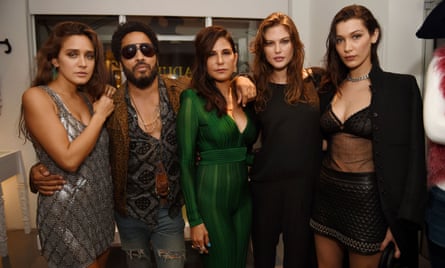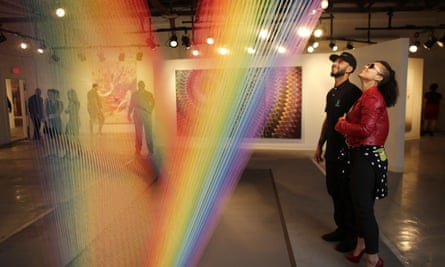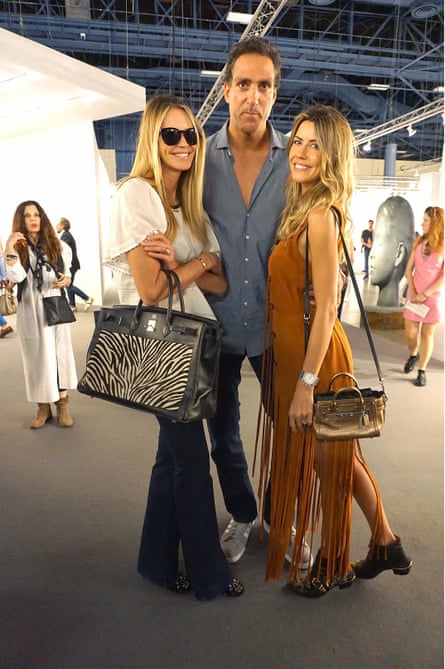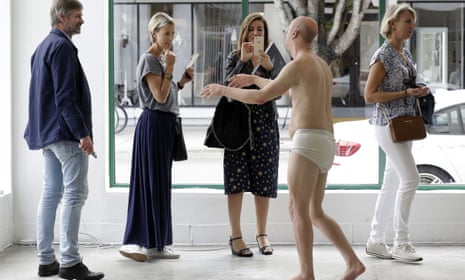Here are a few scenes from the week at Art Basel Miami Beach, the massive art fair in south Florida, and the fêtes and freak-outs that latch onto it. The preview day was as full as ever of buyers flush with cash, flashing their VIP passes and tearing through the halls of the convention center. In the private collectors’ lounge one could learn about opportunities to lease private planes, purchase dubious cigars (still no Cuban ones!), and flash blingtastic watches, all from extremely high-end brands I am disinclined to give free advertising. Beachside hotels hosted “intimate” and “exclusive” dinners for 200 people, while one penthouse party featured a bathtub full of champagne, in which guests wantonly snapped selfies.
And on Thursday night – by which time I had blown out of town, though Instagram made me feel I was watching it all live – a torrential downpour struck, flooding Collins avenue. Partygoers stuck outside at least one party (so I am informed) shoved at the velvet ropes like riot police.

All par for the course at the warm-weather sibling of the esteemed Swiss art fair. Many people in Miami aren’t in town for the fair at all, but simply the conspicuous carousing. It is not at all uncommon to meet party guests, in tight dresses or shirts with not nearly enough buttons buttoned, who have spent serious cash on a hotel room for the week and yet cannot pronounce the word “Basel” or tell you where the fair takes place. Meanwhile, on America’s other coast, more than a dozen people were killed in a mass shooting. The British parliament voted to authorize airstrikes in Syria. A make-or-break climate change conference began in Paris – which, given the rising waters of south Florida, might represent the only hope Miami Beach has of not drowning beneath the Atlantic before the end of the century.
It would be easy to call Miami’s art-and-party nexus tone deaf. The more accurate word would be indifferent. (Last year, Art Basel Miami Beach got underway just as a New York grand jury declined to indict the police officer who killed Eric Garner, and for New Yorkers following their social media feeds, the discrepancy between Black Lives Matter postings and party photos was especially clanging.) Art Basel Miami Beach, much more than its Swiss counterpart and even more than the big-money auctions, has become the bailiwick for public displays of wealth by both fair-going aesthetes and fair-avoiding philistines. Increasingly, those of us with a professional interest in art – curators, critics, artists, museum folks – now arrive in Miami Beach days before the fair begins for a marginally quieter sort of art-looking and socialising, then hightail it before things get really busy.

As I’ve written before, the market for contemporary art has continued to boom over the past 10 years, even as the global economy has swung wildly between emerging-market-fueled turbo-growth and near-depression. Why? Well, there are many culprits. Easy money policies since 2008, and a “new normal” of low yields on bonds and equities, have made art especially appealing for investors seeking returns. (Lack of regulation in the art market is an added bonus.) The entrance of emerging-market collectors into a global art market is another reason. Many of the highest prices for art paid at western auction houses in the last two years have come from Russian, Chinese and Arab buyers; the purchaser of that $170m Modigliani at Christie’s last month was a collector from Shanghai. He charged the painting to his American Express black card.
Also at the root of the art market boom is galloping income inequality in the United States, United Kingdom and other art world centers, which numerous economists have shown is a boon for art prices. When the rich get richer, art does better. If you are inclined to Occupy-inspired rhetoric, you may now find yourself cursing the role of “the 1%” on art and its markets – but as the artist Andrea Fraser has written, no collector of any importance in the art world is bringing home as little as $389,000 a year, the threshold for entry into the top percentile of American earners. The economist Thomas Piketty, of course, has argued convincingly that the returns on capital will exceed economic growth for long into the 21st century. This art boom could therefore go on for a while.

Less well understood is this: even as art benefits from general income inequality, the art world itself is an unequal place. This is not a rising-tide-lifts-all-boats situation. Just like in the big bad economy, the smaller art world economy is one whose biggest rewards accrue to the galleries at the top of the market. Midsize galleries are not doing nearly as well, and in the past two years, as their market share has shrunk and rent has kept rising, several creditable galleries either shut their doors or merged with larger institutions. (In the words of Christian Haye, whose New York galleries rose and fell last decade: “Everybody who deals in contemporary art is either rich or broke, and I’m still broke.”) That inequality extends past dealers to artists: the vast majority of artists earn much less than in-the-spotlight figures such as Damien Hirst and Jeff Koons, if they earn anything from their art at all.
And as scandalous, counterproductive austerity policies have chipped away at public institutions – Portugal’s previous government eliminated its entire culture ministry, while the Netherlands imposed swingeing cuts on museums for no apparent economic reason – private institutions, aided by generous tax benefits for charitable giving, have picked up the slack. Consider the three most important arts institutions to open in Europe in the last 18 months: the Louis Vuitton Foundation in Paris, the Fondazione Prada in Milan, and the Garage Museum of Contemporary Art in Moscow. All were private, and all have direct connections to the luxury industry.

Should I just tune it all out? I’m a critic, not a collector. I don’t buy contemporary art, for ethical reasons and financial ones, and I come to Miami every December for two main reasons: to see new art, especially Latin American art, and to see colleagues from around the world. (Two-and-a-half reasons: I like the beach.) Yet good art cannot exist in a vacuum, and as any serious art historian knows, art has never been divorced from the world that forms it. You can’t get seduced by the market, but turning a blind eye to it is no less irresponsible than turning a blind eye to politics, economics, or social concerns. Nor will it do to cling to outdated and ineffectual fantasies of resistance, as if reciting the full text of Capital in the middle of the Venice Biennale will suddenly lead all of us to the light.
It’s of course important to look for and celebrate alternative models of artistic production and economic exchange. I was deeply moved, for example, by a recent show of the collection of the artist Julie Ault, acquired not with cash but through gifts from and friendly exchanges with other artists. But artists, curators and writers have to find a way to think about art inside the global network of museums, galleries and, yes, even fairs, rather than wait and wait outside for some endlessly delayed renaissance. You really think you can have an economy where the very richest control a massive and increasing piece of the pie – and then have an art scene of radical equality in the same society? Art history doesn’t work like that, and unless the distribution of wealth shifts in a dramatic and improbable fashion, the best we can do is slather on the sunscreen, make sense of the art world’s appeals and imbalances, and find whatever beauty remains in the only world we’ve got.

Comments (…)
Sign in or create your Guardian account to join the discussion